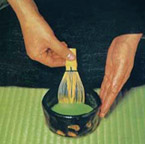|
|
|
|
The Art of Chanoyu: the Japanese tea ceremony

“To those who lust after only cherry blossoms, I want to point out the mountain hamlet spring grasses breaking through the snow.”
~ verse for tea ceremonies taking
place in February
from Chado: The Way of Tea by Sasaki Sanmi
The director of the Urasenke Chanoyu Center, Hisashi Yamada has practiced the Urasenke style of Chanoyu for over 40 years. The Urasenke School is the largest in Japan and the only school that has made an effort to introduce the tea ceremony to other countries. The center in New York City is the headquarters of the private, cultural mission from Japan to the United States. Branches of the center are also located in San Francisco, Hawaii, Seattle, and Washington, D.C. Their mission is to share the art of Chanoyu, meaning “hot water for tea”.
A tradition over 500 years old, the Japanese tea ceremony evolved after traders returned to Japan from China with a powdered green tea called matcha. Originally used for medicinal purposes by an aristocratic class, the drinking of tea eventually merged with Zen philosophy, creating a ceremony that is both spiritual and satiating. The tea ceremony is the quintessential Japanese cultural experience, integrating Zen philosophy, architecture, calligraphy, pottery, floral design, and etiquette.
The ceremony is a celebration of physical beauty and spiritual serenity. Chanoyu is based on four principles: harmony, respect, purity, and tranquility. Of these four, some say tranquility is the most difficult to achieve. “Tranquility means no attachments,” Yamada said, “We have so many attachments, work, money, and people. If you can get rid of some attachments, then your burden is less.”
The purpose of the tea ceremony is a spiritual
experience among those present, usually a group of four or five individuals,
stemming from a sense of communion between the participants, utensils, ambience,
and, of course, the tea. At the Urasenke Chanoyu Center, classes are offered
teaching the art of Chanoyu. Students of all backgrounds and ages are welcome,
and the duration of the semester is indefinite. Initially, students learn to
bow. Then, the instructor will continue teaching the purification of the utensils
and the incorporation of Zen philosophy. 
This lesson plan is an indicator of what students can expect from the center: an environment emphasizing respect and the purity of things and the mind. The spiritual tranquility manifested in the tea ceremony emerges when one learns to disconnect his/her mind from all distractions and focuses on the experience as it occurs. “Many people do not realize how important this moment is,” Yamada said, “This moment is very important, regardless of what you are doing. When you are cleaning the tea spoon, the most important thing in your life is cleaning the tea spoon. When you are cleaning the tea caddy, the most important thing in your life is cleaning the tea caddy.”
For those who may not be able to attend a demonstration or class, here are a few tips on drinking tea in such a ceremony:
~ When preparing to drink the tea, pick up your tea bowl with your right hand, gently cupping the bottom of the bowl with your left palm.
~ Using your right forefinger and thumb to hold the rim, turn the bowl 90º clockwise.
~ Drink the tea in small sips, complimenting the host on the taste of the tea.
~ When you have finished your tea, take some tissue paper and wipe the rim of the bowl from right to left.
~ To return the bowl to its original position in your left hand, place your right thumb on the rim and the remaining 4 fingers beneath the bowl and turn the bowl 90º counter-clockwise.
~ Place the bowl back on the outside of your mat, and take time to admire its shape and design.
Emerging from the ceremony with a peaceful mind will affect every aspect of your life. Those around you will recognize your serenity, and, as with a smile, share it. Ichigo Ichie...every encounter is once in a lifetime.
Director Hisashi Yamada gives demonstrations in the Japan gallery of the Metropolitan Museum of Art every 2 months. In addition, every Wednesday, the Urasenke Chanoyu Center opens a demonstration of the ceremony to the public. Participants learn the philosophy and history of tea while watching the tea-making process and enjoying both tea and sweets.
For more information, visit www.urasenke.or.jp, or email info@urasenke.or.jp.
New Yorker’s click here to find out more about our low rate advertising for this page.
 |
|
 |

|
||
|
©
Melt Magazine 2005
|
||